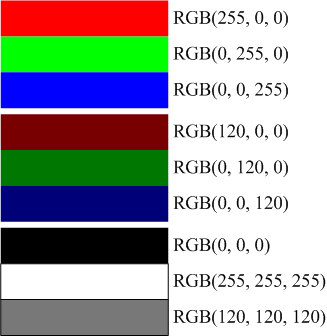

When the masked color number is encountered, a mask is set up, the same size of the screen image. How this operates "under the hood" is somewhat like double buffering. To avoid this, you can plot a semi-transparent color value using a color mask. This is due to the alpha channel value being applied twice to the same set of pixels. When filling such an area on the plot using a semi-transparent color, spurious lines may appear at the polygon boundaries or in areas where the polygons overlap. The filled areas usually consist of a large number of polygons that appear as one solid region. Starting with GrADS version 2.1, there is an addional optional argument that may be used to set a transparency level for a user-defined color.Ī filled region on a plot is achieved by shaded contouring, filling land/ocean areas using basemap.gs, or drawing a shapefile with filled polygons. White will be the color in the center of the new anomaly Of blue and red that range in intensity from fully saturated to very Plotting anomalies, you can define new colors that will be shades It is possible for the user to define new colorsįor example, to create a palette of colors for Shades command to get information about the contour levelsįor some graphics, the 16 GrADS default colors may not be The scripts "cbar.gs" and "cbarn.gs" willĭraw a color key alongside a plot of filled contours or shaded grid Of default contour intervals for filled contours and shaded grid

The same principle is behind the selection When drawing contour plots, the default behaviour of GrADS is to colorĬode the contours and select an appropriate contour interval so thatĮach contour is a different color and the colors span the range of theĭefault rainbow sequence. GrADS creates a default rainbow palette using the following sequence of 13 built-in colors: Of the default colors numbered 0 to 15 are given below:ġ foreground 255 255 255 (white by default)ĭisclaimer: The color samples may not be displayed properly. Every color in GrADS has a unique color number that is usedĪs an index to identify it in GrADS commands. GrADS is built with 16 default colors that are used in a variety ofĪpplications. They may be used within the context of Microsoft applications for the Macintosh, but should not be used when communicating color changes directly to the Macintosh operating system.Controlling Colors in GrADS Controlling Colors in GrADS The RGB color values returned by this function are incompatible with those used by the Macintosh operating system. The following table lists some standard colors and the red, green, and blue values they include: The value for any argument to RGB that exceeds 255 is assumed to be 255.

An RGB color value specifies the relative intensity of red, green, and blue to cause a specific color to be displayed. Number in the range 0–255, inclusive, that represents the blue component of the color.Īpplication methods and properties that accept a color specification expect that specification to be a number representing an RGB color value. Number in the range 0–255, inclusive, that represents the green component of the color. Number in the range 0–255, inclusive, that represents the red component of the color. The RGB function syntax has these arguments: Returns a Long representing an RGB color value. Access for Microsoft 365 Access 2021 Access 2019 Access 2016 Access 2013 Access 2010 Access 2007 More.


 0 kommentar(er)
0 kommentar(er)
